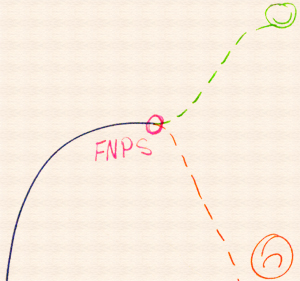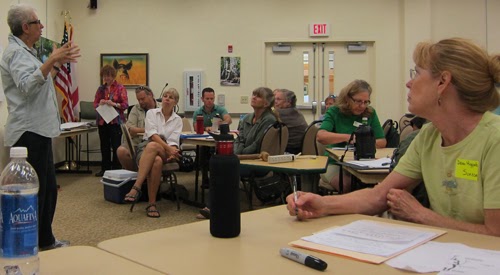F.N.P.S. Board Retreat #2, August 2013
By Laurie Sheldon
 |
| The Bristol Strategy Group's diagram of F.N.P.S. at a point where changes need to be made in order to insure the organization's future growth. |
 |
| F.N.P.S. baby photo |
Don't freak out if none of this makes any sense to you. I probably should have started this piece more chronologically to explain what's going on. Rewind to the year Reagan was elected, gas cost $1.20/gallon, people everywhere were asking "who shot J.R.?" and the Florida Native Plant Society was born. It was 1980. At the time, there were 20 Board Members and 150 members. Today, there are over 3,000 members and something like 60 Board Members. Although the Board has grown in size and brain power, let's just say that, as in many other things, bigger isn't always better. Currently, the Board of Directors consists of an Executive Committee (EXCOMM) and Representatives from each of the organization's 37 chapters. It has become evident that the Chapter Reps (and their respecitve chapters) are not really benefitting from attending Board Meetings, which are largely focused on EXCOMM business. When push comes to shove, what the Representatives really need is to learn about other chapters' successes and failures regarding everything from events (like plant sales) to field trips, and speakers, and to subsequently share that wisdom at their own chapter meetings.
Moving Forward
 |
| Let's not go here, okay?! |
What's that? You are going out of your gourd because we can't just breach our own bylaws? Just sit down and breathe. First of all, if it wasn't legal to change things up a bit, no organization would ever evolve into something bigger and better than its former self... and as scientists, you DO believe in evolution, right? So here's a little Darwin for ya' - natural selection dictates that the species that roll with the punches and make positive changes to their traits (reflecting their changing environments) are going to be the species that stick around and multiply, right? So let's not allow F.N.P.S. to go the way of the 8-track! Current bylaws can be circumnavigated by restructuring "ad hoc" (that's like "beta version" for you tech geeks out there). Once we figure out what works, then we'll adjust the bylaws accordingly. Makes sense, right?
Defining the Council of Chapters
With the Council idea in mind, we got into the business of specifics: purpose, goals, etc. Everyone in attendance was put into a group of about 8 people to do this. Each group brainstormed up a list, then pared down their lists by voting. Eventually all of the groups' pared down lists were combined, and the room voted all together. I think it's fair to say that it was not the most fun thing ever, but we got 'er done. Here's what we came up with...
 |
| Gene Kelly, Shirley Denton, and Anne Cox review their group's list. |
Council Purpose
Align communication and coordination from Chapter to Chapter, B.O.D. to Chapter, and Chapter to B.O.D.
Operational Goals
 |
| Rebecca and Ellen combine all of the groups' lists before a room-wide vote. |
Prioritize issues and develop action plans.
Aspirational Goals
Expand Society's reach to policy makers.
Qualifications for Council Members on the B.O.D.
Member is active and in good standing.
Member has demonstrated leadership and responsibility in own chapter.
Member is willing to commit time and money.
Member is passionate about F.N.P.S. and its mission.
Member has organizational skills.
Member has communication skills and is tech-literate.
Member is knowledgeable about F.N.P.S..
 |
| Kitching Trail Map (L); Anne Cox with Asimina reticulata (R) |
THEN WE GOT TO BREAK FOR THE DAY - YAHOO!
Before heading out to fill our bellies, Anne Cox lead us on a hike through Kitching Creek Nature Trail, which winds through flatwoods along a tributary of the Loxahatchee River. The canopy was largely slash pine, with wiregrass, gallberry, saw palmetto, and wax myrtle in the understory. It was a terrific way to unwind after a day full of list-making.
Day 2
We continued to flesh out details regarding the organization's restructuring on the second day of the retreat. First we determined what the revamped EXCOMM would look like, including a little shuffling around of the current Director positions.
 |
| The rough outline of changes to F.N.P.S. Governance that I presented to my own (Ixia) Chapter |
Then we listed two sets of "initiatives":
Organizational Initiatives
Finance
Governance and Board development
Conference
Fund development
Marketing and outreach (including communication to members, recruitment, and bringing in funds)
Aspirational Initiatives
 Support land management and review of landuse planning
Support land management and review of landuse planningEducational programs
Habitat restoration
After that, we got back into groups of 8 to determine what the best way to select Board members to lead the implementation of those "initiatives." We started with a "Clarity Decision Map" (which, oddly enough, I felt was very confusing), then came up with various constraints and assumptions (below, L) and success factors and solutions (below, R) as per the map.
Last, but not least, we worked out what the future scheduling of the Council of Chapters and B.O.D. might look like.
Council of Chapters
Julie Becker stepped up and took on the responsibility of bringing the Council of Chapters to life (like Dr. Frankenstein, but much more attractive, positive and not scary)! Go Julie! It was proposed that the Council would hold monthly meetings for one year - primarily electronic (via phone, skype, etc). She planned to organize the first Council meeting/orientation prior to December 15, 2013.
Board of Directors
Board meetings were suggested to be held monthly for approximately one year (also primarily electronic) and to last about 90 minutes to 2 hours. Three live meetings would take place: (1) at the conference, (2) an annual planning weekend, and (3) one other (to be determined). Content of meetings would revolve around strategic planning of the following "initiatives":
I. Organizational/Operational Initiatives
A. Annual calendar (what happens, when it happens, who is responsible)
B. Governance and Board development
C. Finance, marketing, and fund development
II. Aspirational Initiatives (comparing goal progress and play... what happened or didn't, etc.)
A. Support of land management
B. Educational programs
C. Habitat restoration
It was a very productive and exhausting weekend. Hopefully, the ideas discussed will come to fruition. If nothing else, know that your current Chapter Reps (now Council Members), Executive Committee Members, and Members-at-Large are doing everything they can to make F.N.P.S. a fabulous organization, and one who you can be proud to be a part of. Go team!
---
Photos and graphics by Laurie Sheldon
Video c/o YouTube





Comments